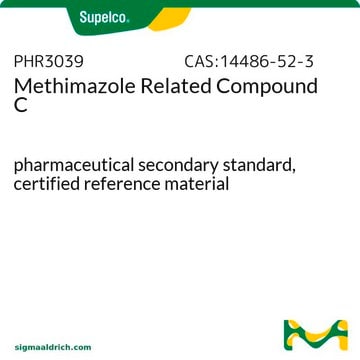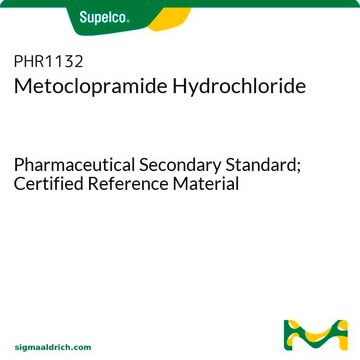1411038
USP
Methimazol-verwandte Verbindung C
United States Pharmacopeia (USP) Reference Standard
Synonym(e):
1-Methyl-2-(methylthio)-1H-imidazol, 1-Methyl-2-(methylsulphanyl)-1H-imidazol
About This Item
Empfohlene Produkte
Qualität
pharmaceutical primary standard
API-Familie
methimazole
Hersteller/Markenname
USP
Anwendung(en)
pharmaceutical (small molecule)
Format
neat
Lagertemp.
2-8°C
InChI
1S/C5H8N2S/c1-7-4-3-6-5(7)8-2/h3-4H,1-2H3
InChIKey
LKIVEIAXFZBGMO-UHFFFAOYSA-N
Suchen Sie nach ähnlichen Produkten? Aufrufen Leitfaden zum Produktvergleich
Allgemeine Beschreibung
For further information and support please go to the website of the issuing Pharmacopoeia.
Anwendung
- Nephrotoxicity Studies in Renal Cells: Methimazole Related Compound C was used in a study to explore the role of biotransformation and oxidative stress in 3,5-dichloroaniline-induced nephrotoxicity. This research provides insights into the cellular mechanisms affected by Methimazole and its related compounds(Racine et al., 2016).
- Phenytoin Teratogenicity Research: Investigations into the bioactivation of phenytoin, involving lipoxygenase-catalyzed reactions that may be relevant to Methimazole Related Compound C, provide critical data on the enzymatic pathways that contribute to drug-induced teratogenic effects. This research assists in the development of safer pharmaceuticals by identifying hazardous metabolites (Yu and Wells, 1995).
- Enzyme Inhibition Studies: The impact of thionamides and related compounds on enzyme activities was studied, highlighting how Methimazole Related Compound C affects important metabolic enzymes like trimethylamine oxidase. This is essential for developing medications that minimize adverse effects on metabolic processes (Pearson et al., 1982).
Hinweis zur Analyse
Sonstige Hinweise
Ähnliches Produkt
Lagerklassenschlüssel
10 - Combustible liquids
WGK
WGK 3
Flammpunkt (°F)
Not applicable
Flammpunkt (°C)
Not applicable
Analysenzertifikate (COA)
Suchen Sie nach Analysenzertifikate (COA), indem Sie die Lot-/Chargennummer des Produkts eingeben. Lot- und Chargennummern sind auf dem Produktetikett hinter den Wörtern ‘Lot’ oder ‘Batch’ (Lot oder Charge) zu finden.
Besitzen Sie dieses Produkt bereits?
In der Dokumentenbibliothek finden Sie die Dokumentation zu den Produkten, die Sie kürzlich erworben haben.
Unser Team von Wissenschaftlern verfügt über Erfahrung in allen Forschungsbereichen einschließlich Life Science, Materialwissenschaften, chemischer Synthese, Chromatographie, Analytik und vielen mehr..
Setzen Sie sich mit dem technischen Dienst in Verbindung.



